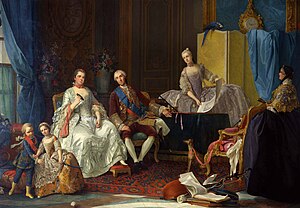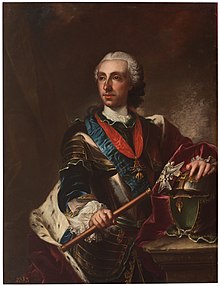|
Philip, Duke of Parma
Philip (Spanish: Felipe, Italian: Filippo; 15 March 1720 – 18 July 1765) was Duke of Parma from 18 October 1748 until his death in 1765. A Spanish infante by birth, he was born in Madrid as the second son of King Philip V and Queen Elisabeth. He became Duke of Parma as a result of the 1748 Treaty of Aix-la-Chapelle. The duchy had earlier been ruled by Philip's elder brother, the future Charles III of Spain, and by their maternal ancestors. Philip founded the House of Bourbon-Parma, a cadet line of the House of Bourbon. He was a first cousin and son-in-law of the French king Louis XV. LifeBorn at the Royal Alcazar in Madrid as Felipe de Borbón y Farnesio, he was the third child and second son of Philip V of Spain and his wife, Elisabeth Farnese. He was raised in Madrid and as a child showed more interest in art than in politics. He was also the 12th Count of Chinchón and Grandee of Spain First Class with a coat of arms of Bourbon after the alienation with royal authorization in 1738 of the 11th Count of Chinchón, Don Jose Sforza-Cesarini, Duke of Canzano, a title he later ceded to his brother Louis in 1754.  His mother came from the family of Farnese, which had ruled the Duchy of Parma, Piacenza and Guastalla for many generations. The duchy had been ruled between 1731 and 1736 by his elder brother Charles, but was exchanged with Austria for The Two Sicilies after the War of Polish Succession. Twelve years later, in the Treaty of Aix-la-Chapelle (1748), Austria lost the duchy and Philip became the new duke, founding the House of Bourbon-Parma. As part of the Second Treaty of Versailles (1757) between Austria and France, it was intended that Philip would become king of the Southern Netherlands in a deal that would see French troops occupy key positions in the country – however this arrangement was repudiated by the subsequent Third Treaty of Versailles and Philip continued in Parma. The Duchy of Parma was ruined by many years of warfare, and in 1759 Philip named the able Frenchman Guillaume du Tillot as his minister to restore the economy. Philip was an enlightened ruler who stimulated education and philosophy, attracting personalities like Étienne Bonnot de Condillac and Alexandre Deleyre. Marriage Philip married his first cousin once removed Princess Louise Élisabeth of France in Alcalá de Henares, Spain on 25 October 1739. They had three children.
Their marriage was an unhappy one, and Louise Elisabeth died of smallpox at the age of 32 in 1759. Philip died unexpectedly on 18 July 1765 in Alessandria, Sardinia, after having accompanied his daughter Maria Luisa on her way to Genoa, where she sailed for Spain to marry Infante Charles. Through Philip's daughter Maria Luisa, he is an ancestor of the Bourbons of Spain, the Bourbons of the Two Sicilies, and the House of Orléans. Honours
Ancestors
Heraldry
ReferencesWikimedia Commons has media related to Philip, Duke of Parma.
|
||||||||||||||||||||||||||||||||||||||||||


![Coat of arms as Infante of Spain[2]](http://upload.wikimedia.org/wikipedia/commons/thumb/1/16/Coat_of_Philip%2C_Duke_of_Parma_as_Spanish_Infante.svg/232px-Coat_of_Philip%2C_Duke_of_Parma_as_Spanish_Infante.svg.png)
![Coat of arms as Duke of Parma, Piacenza and Guastalla[3]](http://upload.wikimedia.org/wikipedia/commons/thumb/f/f5/Ducal_Coat_of_Arms_of_Parma_%281748-1802%29.svg/189px-Ducal_Coat_of_Arms_of_Parma_%281748-1802%29.svg.png)
